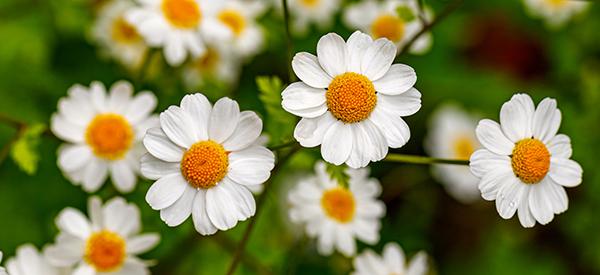
Feverfew
Feverfew (Tanacetum parthenium) is a useful healing plant. As its name suggests, this herb is beneficial in reducing fever. This weedy perennial shrub bears a cluster of white florets with a yellow button-like center. The flowerheads are long-lasting, making them an ideal plant for cut flowers. Feverfew is often used to fill floral arrangements, either as dried or fresh flowers. More than its beautiful bloom, feverfew is considered the “medieval aspirin” with its potent ability in healing various illnesses.
Feverfew’s genus Tanacetum is derived from the Greek word Athanasia which means immortal. Parthenium is about the Greek Parthenon. Accordingly, the plant once treated a worker who fell while working on the Parthenon.
Feverfew is a Eurasian herb used for centuries in treating headaches and conditions pertaining to childbirth and labor. In the fifteenth century, it was used for countering sterility and treating poison. The cultivation of feverfew spread around the world including in North America. In Nordic countries, feverfew is registered as a traditional medicine with the brand name Glitinum.
Where Feverfew Is Found
Feverfew grows abundantly in Europe, Central Asia, and West Himalayas. They prefer subtropical and tropical climates although they can also grow in temperate home gardens. Feverfew is a slow-growing herb that lines mountain scrubs, rocky slopes, and wastelands.
Related: The Complete Map of Edible Plants: Find Out What You Have in Your Area! (Video)
How To Identify Feverfew
Feverfew grows in clumping mounds that bear beautiful white florets from June to September. It emits a strong and bitter odor that attracts butterflies, bees, and hummingbirds. Feverfew grows abundantly in the meadows, but they are also best for rock gardens and as a container plant.
 Leaves: Feverfew leaves are green, feathery, and fern-like, with tiny hairs on the underside. They are compound with a cuneate base and oval leaf blade, wide at the middle and tapers at both ends. The leaves are arranged alternately, with one leaf per node along the stem.
Leaves: Feverfew leaves are green, feathery, and fern-like, with tiny hairs on the underside. They are compound with a cuneate base and oval leaf blade, wide at the middle and tapers at both ends. The leaves are arranged alternately, with one leaf per node along the stem.- Flowers: The white, daisy-like flowers dot the feverfew plants during their blooming season. It measures about ¾ inches in diameter with 10 to 30 petals around a button-like yellow center. Feverfew flowers are arranged in corymbs.
- Fruits and Seeds: As feverfew matures, it sheds away its petals. The yellow disk becomes a head of dry, brown, or copper seeds. The seeds are tuft-type with pappus that measures about 1 to 2 mm long.
- Roots: Feverfew has a deep taproot system and branching rhizomes.
- Stem: Feverfew stems are erect and branched. They are green and circular, but with lots of small angles. It has fine hairs only on the nodes but is smooth on the overall surface.
Related: Plant Identification Guide – 400 Wild Plants That You Can Forage For (Video)
Tanacetum parthenium is a member of the Asteraceae or aster family. Feverfew is known in many names like Santa Maria, Altamisa, bride’s button, bachelor’s button, featherfoil, flirtwort, and midsummer daisy.
It also has different varieties. However, the most widely available are the following:
- Aureum or Golden with golden leaves and white flower
 Crown White is pure white with tiny buttons
Crown White is pure white with tiny buttons- Golden Ball has a double creamy yellow bloom
- Rowallane are pure white and button-shaped
- Ultra Double White has a double white flower
- White Bonnet that bears white bloom and 18 inches tall
How To Grow Feverfew
Feverfew has little to no culinary use, which makes them almost unavailable in most grocery stores. To get your hands on fresh herbs, it is best to grow your own pot of feverfew. They can propagate either through seeds, root division, or cuttings.
Native to Europe and Asia, feverfew can also grow in USDA Hardiness zone 5 to 10. The plant can get invasive underground or through aggressive re-seeding. Thus, you might want to reconsider the area where you want feverfew to grow.
Also, it may be difficult to find feverfew seeds in local stores. But, you may get some in online merchants that are ready for planting. Another thing about the annual varieties is their sensitivity to the extreme cold, which means you need to give them special care during winter.
Propagation by Seeds
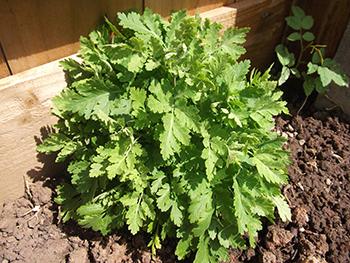 When growing feverfew from seeds, it is ideal to start them indoors in late winter. You may also directly sow feverfew seeds in your garden after the danger of frost has passed. Sow the seeds in well-drained soil and cover them lightly with loose soil, about a quarter inch. Plant them in rows a few inches apart and thin them to about a foot later on.
When growing feverfew from seeds, it is ideal to start them indoors in late winter. You may also directly sow feverfew seeds in your garden after the danger of frost has passed. Sow the seeds in well-drained soil and cover them lightly with loose soil, about a quarter inch. Plant them in rows a few inches apart and thin them to about a foot later on.
If you are sowing them in a potting tray, cover it with a plastic sheet and place it in a bright location. Keep the container moist until the seeds germinate for about 10 to 14 days.
Transplant the feverfew seedlings when two of its true leaves have emerged. Feverfew Seeds Available For Purchase Here!
Propagation by Division
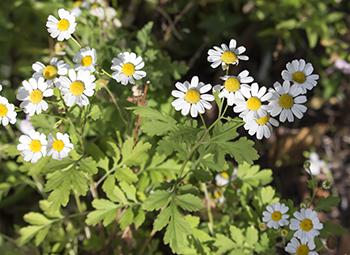 If you find feverfew in the meadows, the most sensible way of propagating it is through root division. It has a deep taproot and branching rhizomes, so dig the plant about a foot deep and a few inches wide. Cut the crown into chunks using a sharp spade and replant them with the same depth as its roots. Provide at least 18 inches of space between the divisions and water them well.
If you find feverfew in the meadows, the most sensible way of propagating it is through root division. It has a deep taproot and branching rhizomes, so dig the plant about a foot deep and a few inches wide. Cut the crown into chunks using a sharp spade and replant them with the same depth as its roots. Provide at least 18 inches of space between the divisions and water them well.
Propagation by Cuttings
Propagate your feverfew plants by stripping the young shoots from the base of the plant in summer. Take it with a few inches of the heel of the parent plant attached to better assist in rooting. Dip them in a rooting hormone and plant them in a soilless potting mix. You may use the heat mat to keep the feverfew cuttings warm until their roots develop. Transplant them in the garden when it is already sunny and after the last frost date.
Related: 10 Plants That You Should Never Plant Together (Video)
Plant Care and Maintenance
The best thing about feverfew is that it is not fussy about soil. They can grow anywhere as long as it does not always get their roots wet. It will also bloom best in well-drained soil without heavy clay. However, once feverfew is established, it will be hard to get rid of them as they are aggressive in spreading.
Deadheading the feverfew at the end of its growing season can minimize excessive reseeding. You may also cut its vibrant flowers and use them for flower arrangement to encourage better bloom.
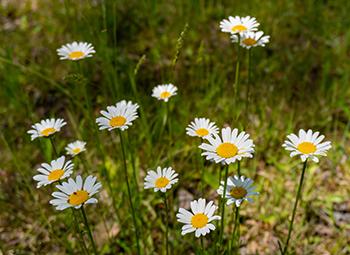
Feverfew may suffer from insect problems like aphids, powdery mildew, and spider mites. You can best avoid them by planting garlic, cress, or geraniums as companion plants for feverfew.
Here are some tips to grow feverfew in the best condition:
- A full to a partially sunny spot
- Medium, well-drained soil
- Regular watering but not too soggy
- Mulching in winter and summer
How To Harvest Feverfew
The leaves, flowers, and sometimes stems of the feverfew plant are harvested for medicinal purposes. Leaves can be harvested anytime, while the flowers can be taken once it blooms. When harvesting feverfew flowers, do it at the beginning of the flowering season.
Dry feverfew right after harvesting and keep them in a cool and dry place. Remember not to store the herb for more than 3 months since it loses its potency by then.
What Feverfew Is Good For And Natural Remedies Made From It
Feverfew is a traditional remedy for treating headaches like migraines, cluster headaches, and tension headaches. It contains natural substances that help dilate the blood vessels to ease the constriction that causes headaches.
Feverfew encourages the smooth flow of blood to prevent clotting. It may lower blood pressure and help combat heart problems.
The usefulness of feverfew is observed in its ability to lower body temperature in fever. Most traditional herbalists often prefer using feverfew over aspirin. It is an excellent analgesic and antipyretic that relieve any kind of pain. It treats inflammation, thereby, alleviating the pain muscle and joint pains.
Feverfew, as a stimulant, is also an emmenagogue that regulates menstrual flow. It reduces the pain and cramps in menstruation and is referred to as the women’s herb. For pregnant women, feverfew helps in the progress of uterine contraction to reduce the labor time.
When applied topically, feverfew contributes to good skin health. It reduces dermatitis, psoriasis, and any kinds of skin irritations including insect bites.
People with severe hair loss may find a cure in feverfew.
Feverfew encourages hormonal activity that can induce hunger to improve appetite. It helps in the healing process of individuals who are underweight and are calorie-deficient. Patients recovering from surgery can improve their appetite by taking feverfew as well.
Modern research explores the potency of feverfew for treating cancers. It has parthenolide and other flavonoids that give an inhibitory effect. Thus, it may hold out hope for patients suffering from breast or cervical cancer.
The soothing ability of feverfew, paired with its excellent anti-inflammatory effect, is best for respiratory problems. It can treat cold, cough, chest congestion, and other illnesses like asthma and chronic bronchitis. Using feverfew may boost and improve the overall respiratory health.
In digestive problems, the carminative and antispasmodic properties of feverfew are beneficial. It can ease stomach pain, constipation, and other digestive complaints.
Related: 10 Medical Supplies You Need to Have in Your House (Video)
To sum, the health benefits of feverfew are observed in the homeopathic treatment of the following:
- Rheumatoid arthritis
- Inflammation

- Fever
- Headache and migraine
- High blood pressure
- Dermatitis and skin problems
- Cancer
- Menstrual and labor problems
- Baldness
- Respiratory problems
- Digestive issues
- Kidney and colon problems
- Underweight complaints
What Parts Of Feverfew Are Used For Remedies?
The fresh and dried leaves and flowers of feverfew are important parts in the preparation of many herbal remedies. They are primarily used in oral and topical applications. Sometimes, the stems are also utilized but only on rare occasions.
Feverfew exudes a bitter flavor, so it is not popular in culinary use. But the dried feverfew flowers are sometimes added to pastries and other dishes in limited uses.
For oral use, feverfew decoction and tea are the most popular. Feverfew infusions are taken to reduce muscle and joint pains. It is also available in capsules, using the dried and crumbled feverfew leaves. A tincture or concentrated feverfew extract is used for fever and infection.
Topically, the bruised leaves of feverfew are applied in the body areas of concern. But you may also avail of salve or ointments for treating skin problems. For massaging stiff muscles, feverfew is also available in oil form.
Feverfew Insect Repellent
Ingredients:
- 2 tbsp dried feverfew leaves (or 1/4 cup fresh leaves)
- 1 cup of boiling water
Steps:
- Place the feverfew leaves in a bowl.

- Pour boiling water over the leaves. Let it steep for 5 minutes or until the water has cooled.

- Strain with a cheesecloth to remove the plant particles from the cooled tea. Transfer to a fine mist spray bottle if you have any.

How to use this remedy:
The cooled tea can be applied to the skin. It acts as a natural insect repellent with the ability to ward off mosquitoes, biting flies, and gnats. It can also work as a natural flea rinse on pets. But before applying it on the skin or your dog, make sure to test it on a small area of the skin first. Allergies may occur with the use of feverfew. Hence, it is best to do a patch test and always consult a medical professional if you are in doubt.
You may also consider putting a pot of a feverfew plant, or cut feverfew flowers on a vase, near you to ward off the insects. The smell of the plant alone is enough to keep the insects at bay.
What Plants Resemble Feverfew
| Feature | Feverfew (Tanacetum parthenium) | Roman Chamomile (Chamaemelum nobile) | Wild Chamomile (Matricaria chamomilla) |
|---|---|---|---|
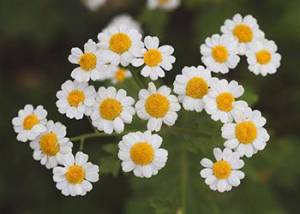 |  | 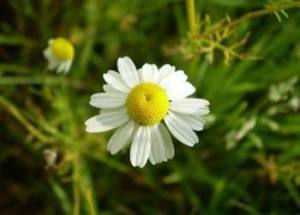 | |
| Size | Up to 70 cm | 15 to 60 cm | 20 to 40 cm |
| Leaves | Green; compound; alternate; fern-like | Green; broadleaf; compound; finely-divided | Oblong; compound; fern-like; feathery |
| Flowers | Small; daisy-like; white with a yellow center | Small; conical; white with a yellow center disk | Daisy-like; white with a yellow center |
| Stem | Stiff; erect; branched; circular | Erect; smooth; branched; light green | Erect; branched; smooth |
| Fruit | Dry; brown; with tuft seeds | Brown to copper; achene | Dry; brown; tufted |
| Scent | Strong; bitter; citrusy | Warm; smoky-floral | Sweet; apple-like |
Warnings and Cautions:
Feverfew is unsafe for pregnant women and can cause abortion. It is also not advisable for breastfeeding women and children below two years old.
Do not take feverfew if you are allergic to ragweed, yarrow, and chamomile.
Avoid any feverfew supplement when scheduled for surgery as it can interact with the anesthesia.
Feverfew may also increase the risk of bleeding and slow down the body’s blood clotting process. Do not use it if you have a bleeding disorder.
If you take feverfew for more than one week, do not stop taking it abruptly. It may cause rebound migraine, headaches, anxiety, and muscle and joint pain.
Do not chew fresh leaves of feverfew. It may result in mouth sores, swelling, and loss of taste.
Herbs like feverfew can interact with other herbs and medications. Use it with caution and under the supervision of a qualified health care provider. Avoid using this if you are consuming blood-thinning drugs and painkillers.
You may also like:
DIY Headache Recipe For Instant Pain Relief
The Legal Narcotic You Can Grow In Your Own Backyard (Video)
The Best Flowers to Attract Beneficial Insects to Your Garden








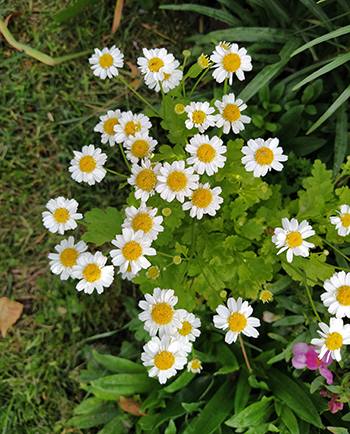 Leaves: Feverfew leaves are green, feathery, and fern-like, with tiny hairs on the underside. They are compound with a cuneate base and oval leaf blade, wide at the middle and tapers at both ends. The leaves are arranged alternately, with one leaf per node along the stem.
Leaves: Feverfew leaves are green, feathery, and fern-like, with tiny hairs on the underside. They are compound with a cuneate base and oval leaf blade, wide at the middle and tapers at both ends. The leaves are arranged alternately, with one leaf per node along the stem.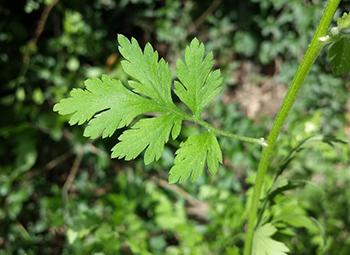 Crown White is pure white with tiny buttons
Crown White is pure white with tiny buttons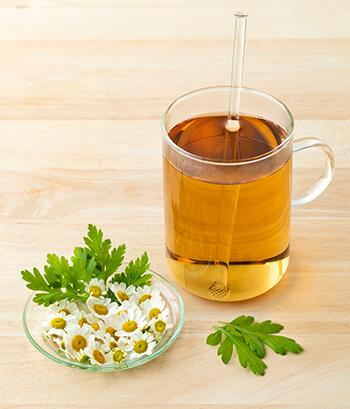
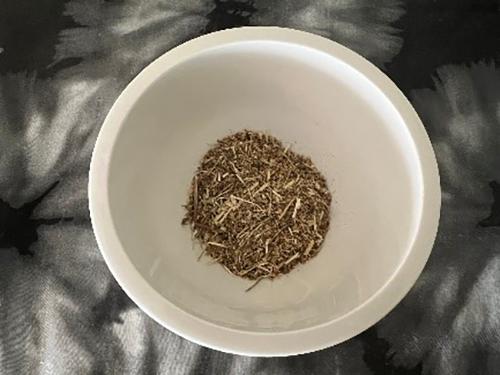
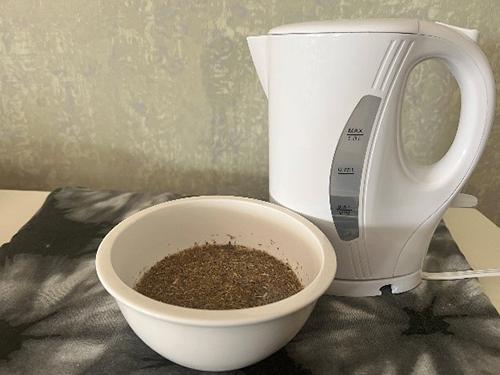
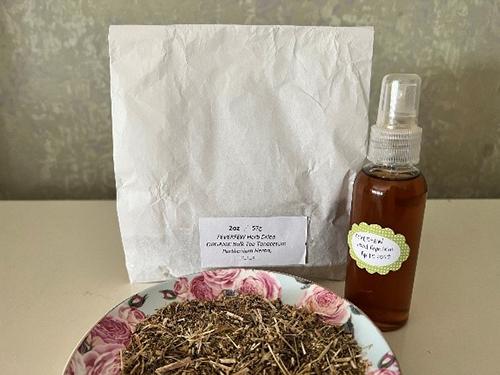




Mrs. Nicole Apelian. May I call you Nicole. Do you have a book with the ingredients and steps how to process each herb ? I recently purchased The Lost Herb Remedies.
Thank you for this post! I knew very little about feverfew before reading this, but had bought seeds online for its migraine benefits. Feverfew has far more benefits than I thought! That is the way with herbs, though.
Hi, I was wondering how you use it for thinning hair.
Hi Debbie,
Feverfew is very beneficial for reducing hair fall. This is because of its anti-inflammatory properties.
People using this herb regularly have experienced a great reduction in hair fall. It is not recommended that you use feverfew herb directly on your scalp. This can lead to side effects. So, the best way is to drink feverfew tea. This helps in stopping hair fall and also keeps you away from baldness.
Here you can find more recipes for hair loss:
https://thelostherbs.com/use-this-recipe-if-youre-losing-hair/
https://thelostherbs.com/diy-honey-infused-hair-oil/
https://thelostherbs.com/easy-diy-hair-growth-serum-recipe/
Many blessings and good health!
It’s all that, but it actually repels bees – at least in Western N. America. It self propagates, so it doesn’t need to attract pollinators. I am a botanist, I’m trying to help native bees. I recently started pulling up all the feverfew in my garden because it’s not good for native bees here. Maybe in its native habitat it does something for pollinators, but where I live it’s best grown in small quantities.
I LOVE your tinctures especially Yerba Santa, but I take your tinctures daily and I’m finally feeling better! But that’s an aside, right now I’m trying to help bees.
In the article it says: “For pregnant women, feverfew helps in the progress of uterine contraction to reduce the labor time.” Yet in the warning section: “Feverfew is unsafe for pregnant women and can cause abortion.”
Conflicting information is very confusing.
Hi,
Thank you.
What else can we use because my fiance is a bleeder?
We are looking for something to help relieve the cluster headaches.
It states, good for childbirth because it helps speed up contractions. So obviously not good to take unless you are over delivery time and need aid with contractions, or don’t want to be pregnant at the beginning. Obviously do not take it during pregnancy or you could have early contractions and lose the baby. Hope that helps.
In the warnings it says do not chew fresh leaves of feverfew. In The Lost Book Of Herbal Remedies that I’ve purchased it states on page 78 ‘chew 1 to 4 leaves per day’. I wonder which one is correct, could you advise? Thank you
Feverfew is not just good for migraines it works great for all body pain. I discovered that in a little snippet of an article on line. It was a life changing, life saving event. The only downside is that it only lasts a couple hours. But I’ll take it!